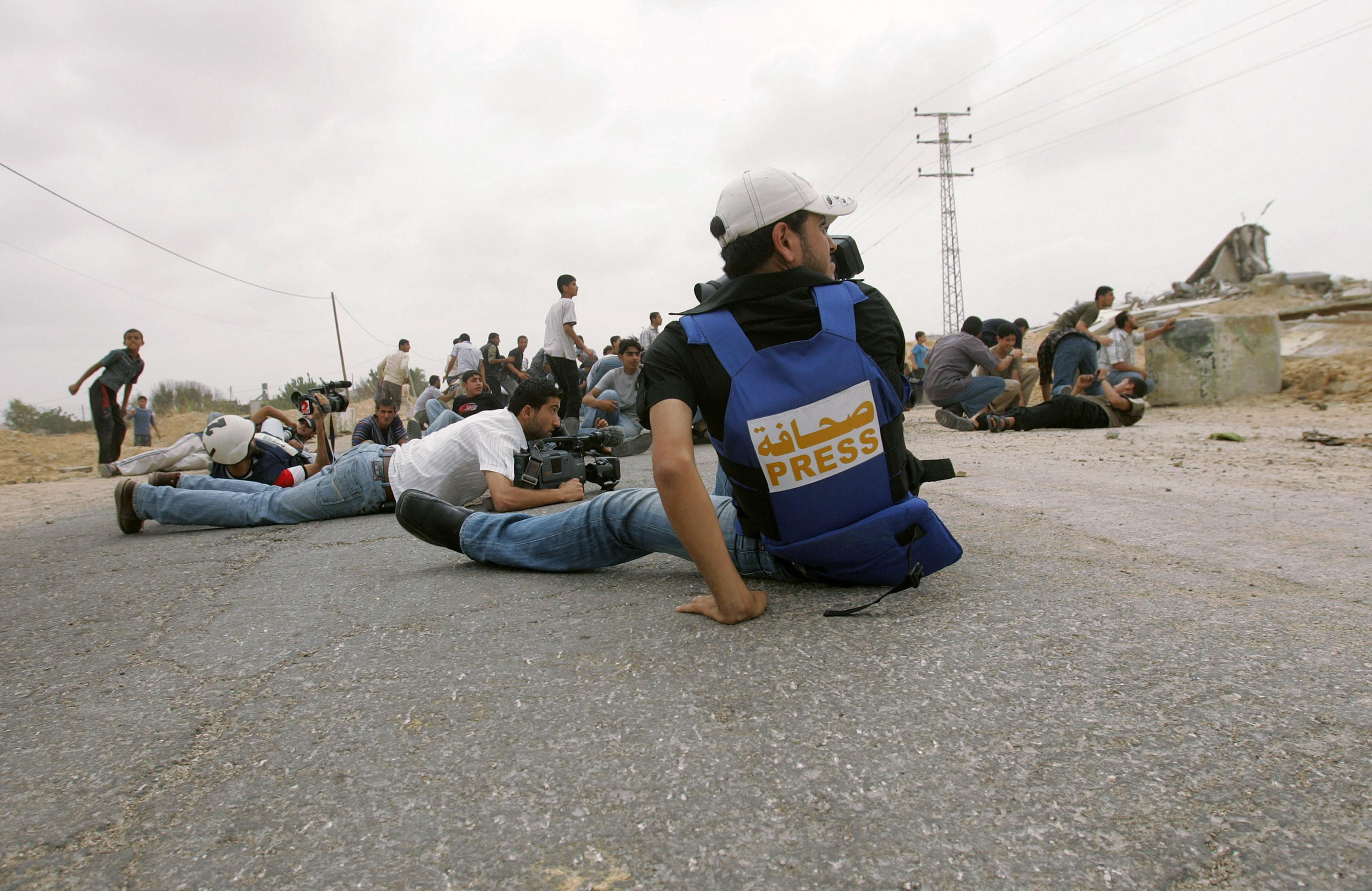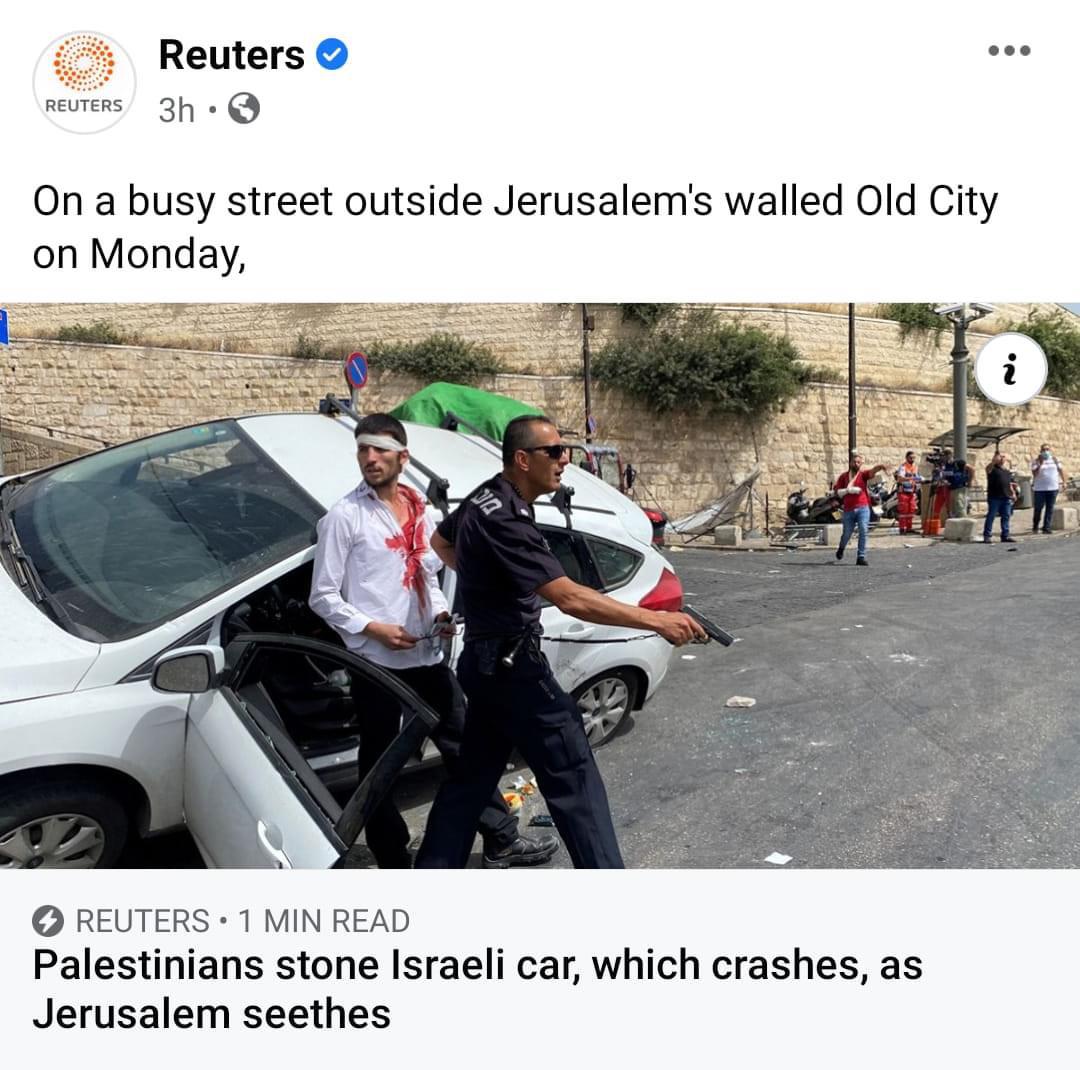As journalists, we follow a few simple rules in order to communicate as clearly as we can with our audience.
One of the first rules we learn is to always write in the active voice, so it is evident who is doing an action, what the action is, and to whom the action is being done. Consider the following sentence: “Man kills wife and children in fit of rage.” In this sentence, we have identified the criminal, his victims, his actions and his motive for said actions.
Basic stuff. And yet for some reason, current reporting on the ongoing Israeli bombardment of Gaza and the escalating conflict between Israelis and Palestinians is willfully ignoring these basic rules. Take the following tweet from German News Outlet Deutsche Welle on May 12, 2021.
This tweet flouts all the basic principles of a proper headline, to the detriment of the audience.
Due to its reliance on passive voice, the reader does not know who did the action, what the action is (children having been killed is not an action, it is a consequence), or how the action happened. Further, the muddled language of the headline leads one to believe that the nine children were killed while fighting Israel—which is obviously not the case.
If we rewrite the tweet according to the proper conventions of headline-writing, it would sound more like this: “Israeli airstrikes kill nine children in Gaza Strip.” Now we know who killed the children, how they were killed, and the consequences of Israeli airstrikes.
The strange tendency of so many reputable news outlets to suddenly write vague and misleading headlines when it comes to Israeli actions in Palestine not only points towards a bias towards the Israelis, but also misleads readers.
For example, a Reuters headline on May 10 describing what appears to be a ramming of a crowd of Palestinian protesters by an Israeli driver completely leaves out the ramming, and the fact that a Palestinian man was struck by the vehicle. Even if the ramming was unintentional, the main event of the story, the ramming of a vehicle into a crowd of protesters, should be the focus of the headline, and should certainly not be described as a mere “crash.” Readers scanning the headlines or scrolling through social media, would have no idea that this ramming ever took place.
Compare the headline to another Reuters headline describing a very similar event last year, where it appeared a Palestinian rammed his car into a police checkpoint.
Here the Reuters headline puts the car-ramming front and center. Though there was the same doubt present over whether or not the crash was intentional or the result of losing control of the vehicle, Reuters did not describe it as a “crash.”
What is the difference here? One driver was Israeli and one was Palestinian.
“Clashes”
Already social media is inflamed with criticism over journalists’ use of “clashes” to describe the raiding of Al-Aqsa mosque and the subsequent protests in which Palestinians threw stones.
To be clear, “clashes” is a term which belongs to the realm of diplomacy and is better situated within the clinical language of a government press release rather than a newspaper article which seeks to inform. Diplomats use the term because they either do not want to appear biased to one side, or because they want to sanitize the bloodshed which their allies caused.
Unlike diplomats, journalists’ job is not to sanitize or mask the true consequences of violence. Instead their duty is to inform the readers of the current situation, its long term consequences, and its root causes. “Clashes” should only be used in an article when the journalist does not know the exact circumstances of an event, only that violence occurred between two sides.
But in Jerusalem, and now in Gaza, all the details are known. A flood of pictures and videos have documented the Israeli crackdown, bombardment of the Gaza strip and Hamas’s rockets landing in Tel Aviv.
The continued use of terms like “clashes” obscures details from the audience and implies an equality of force between the Israeli and Palestinian side which is contrary with the true power dynamics in Israel and the Palestinian territories. A confrontation between well equipped soldiers backed by one of the most militarily powerful states in the world and protesters with stones is not a “clash.” A mob of Israelis dragging an Arab driver from his car and beating him unconscious is not a “clash,” it is a lynching.
Further, in establishing the immediate causes of the latest flare up in violence, it’s important to give a full context to readers. It is not just the raid in al-Aqsa or the cleansing of Sheikh Jarrah of its Palestinian residents which has led to Palestinian anger, but instead decades of oppression under an apartheid system which have led to the current fighting.
Compare this 1986 New York Times article on a riot in Apartheid South Africa to today’s coverage of the situation in the Palestinian Territories and Israel.
The article opens immediately with a direct description of who was killed, and who killed them. Notably, the victims are put front and center.
“Eleven blacks were shot dead by security forces and 62 other people injured in a night of street fighting that engulfed a section of Soweto overnight.”
There is no passive voice vaguery here.
The article goes on to immediately frame the riots and confrontations with the local security forces—whose trigger was also the attempted eviction of residents from their homes—as a response to long-running political grievances.
“Rents yield most of the revenue for township administrative authorities, many of them unpopular bodies, and so part of the protest stemmed from resentment of what black activists call the financing of their own oppression.”
Journalists covering the events in the Palestinian Territories and Israel should similarly put political grievances of the Palestinians front and center. Otherwise, portraying the current situation as a tit-for-tat exchange ignores the less visible, but just as important, forms of violence perpetrated against Palestinians under the Israeli apartheid system for decades.
Chronology and proportionality
In reporting on ongoing conflicts, establishing a clear timeline for readers is crucial. Doing so helps the audience wade through the outpouring of details, most of which involve military technology and geographies which are unfamiliar to the general reader.
As Michael F. Brown of the Electronic Intifada wrote on May 11, many of the most prominent western outlets are failing to establish a proper timeline of events in the exchanges of rocket fire between Hamas and Israel.
Brown notes that media outlets should treat the Israeli raid on al-Aqsa as the first act of aggression of the conflict, not the rockets launched by Hamas. Hamas warned Israel that if it did not withdraw its forces from al-Aqsa by 6 pm on May 10, it would retaliate. By framing Hamas’ launching of rockets as the cause of the current conflict and establishing Hamas as the aggressor, journalists completely wash over Israel’s actions in al-Aqsa and promote one side’s narrative at the expense of the other.
Finally, there is the issue of proportionality. Here we will first use the term as it’s defined in International Humanitarian Law (IHL), then in its more conventional usage.
In IHL, the principle of proportionality necessitates that any “collateral damage” from military action must be justified by the “anticipated military gains” from said military action. This means that if a military force targets a senior military leader in an airstrike, and mistakenly kills a civilian in the process, the casualty is probably justified due to the strategic gain of killing the military leader.
Without access to classified information or the Israeli war room, it’s impossible to definitively say that Israel is violating this principle in Gaza. However, the leveling of entire apartment buildings in Gaza certainly does not seem to be in the spirit of proportionality. Journalists should do well to at least raise the question over whether or not this principle is being respected. If it is not, then serious allegations of war crimes come into play—which, in any other context, would be a journalist’s wet dream to be the first to report on.
In its more conventional usage, proportionality refers to an equal response. What is happening in Gaza is clearly disproportionate to the attacks that Hamas launched against Israel. While Israeli citizens are rushed to bomb shelters and are somewhat protected against rockets by the Iron Dome missile defense systems, Gazans wait out in the open, hoping their building will not be struck next.
Already the casualty figures point to a pitched conflict. As of the article’s publishing, 83 Palestinians have been killed in Gaza and six Israelis have been killed. Bombs dropped by Israeli fighter jets flatten entire buildings in the Gaza Strip, creating far greater destruction than anywhere seen in Israel.
Military leaders have no incentive to fight fair; inflicting the maximum damage while minimizing your own is a good strategy and is in fact a key part of Israeli military doctrine. This is the entire logic behind asymmetric warfare, and is what enables American soldiers stationed in Nevada to rain death upon Pashtun farmers in Afghanistan with the twitch of a joystick.
However, journalists are not soldiers. What is good strategy for the Israeli military might mean death and terror for Palestinians trapped in the open-air prison that is Gaza. Journalists have a duty to report on this with a sensitivity and preciseness that highlights the very human plight of those affected.
By adopting a tone of clinical detachment, journalists hope to demonstrate that they are treating both sides equally. However in the process, they are masking just how deeply unequal this conflict really is.
*Picture: Journalists take cover while Israeli tanks and snipers open fire during a demonstration to mark the 60th anniversary of al-Nakba on May 15, 2008 in the Gaza Strip. (Abid Khatib - Getty Images)








































